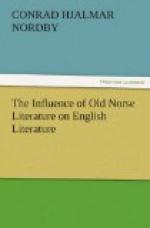It is impressed upon the reader of an epic that the plan of its maker does not call for fine analysis of character. The epic poet is concerned necessarily with large considerations, and his personages do not split hairs from the south to the southeast side. One sign of this is seen in the epic formulae employed to characterize the personages of the story. Such formulas are in Sigurd the Volsung in abundance, as we have noted on another page. But there are also many departures from the epic model in this poem. Some of these we have referred to in the remarks on Book III, where we noted Sigurd’s mental sufferings. In Book IV we have a discrimination of character that is not epic, but dramatic in its minuteness. In the speech and the deeds of the Niblungs their pride and selfishness is clearly set forth, but the individual members of that race are distinguished by traits very minutely drawn. Thus Hogni is the wary Niblung, and is averse to accepting Atli’s invitation:
“I know not, I know
not,” said Hogni, “but an unsure bridge
is the sea,
And such would I oft were
builded betwixt my foeman and me.
I know a sorrow that sleepeth,
and a wakened grief I know,
And the torment of the mighty
is a strong and fearful foe.”
(P. 281.)
Gunnar is here distinguished as a hypocrite by word and deed; Gudrun remembers Sigurd in her exile and schemes and plots to make her husband Atli work her vengeance on the Niblungs; Atli is greedy for gold and Gudrun’s task is not hard; Knefrud is a liar whose words are winning, and overcome the scruples of the Niblungs. In these careful discriminations of character we see a non-epical trait, and of necessity therefore, a non-Icelandic trait. The sagaman was epic in his tone.
As a last appreciation of the art of William Morris as it is displayed in this poem, we would call attention to the tremendous battle-piece entitled “Of the Battle in Atli’s Hall.” It is the climax of this marvelous poem, and in no detail is it inadequate to its place in the work. The poet’s constructive power is here demonstrated to be of the highest order, and in the majestic sweep of events that is here depicted, we see the poet in his original role of maker. The sagaman’s skill had not the power to conceive this titanic drama, and the memory of his battle-piece is quite effaced by the modern invention. In blood and fire the story comes to an end with Gudrun,




